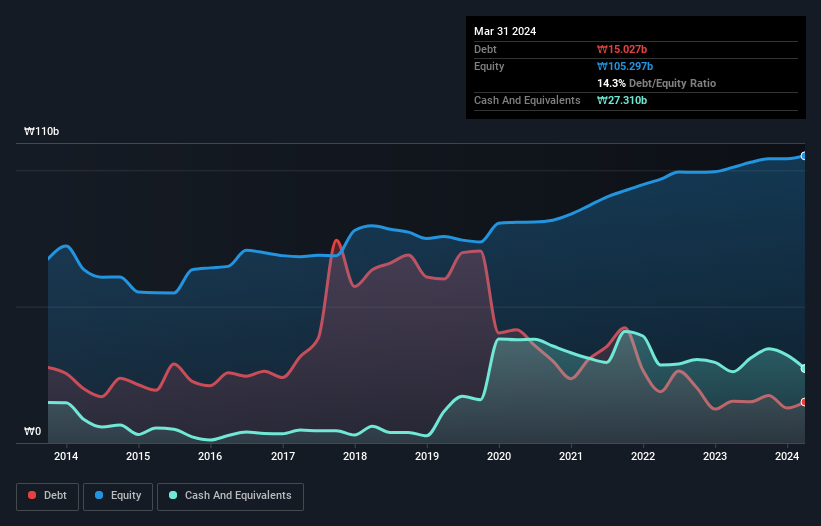- South Korea
- /
- Trade Distributors
- /
- KOSDAQ:A014190
Wonik Cube (KOSDAQ:014190) Could Easily Take On More Debt
Legendary fund manager Li Lu (who Charlie Munger backed) once said, 'The biggest investment risk is not the volatility of prices, but whether you will suffer a permanent loss of capital.' It's only natural to consider a company's balance sheet when you examine how risky it is, since debt is often involved when a business collapses. Importantly, Wonik Cube Corp. (KOSDAQ:014190) does carry debt. But the more important question is: how much risk is that debt creating?
When Is Debt Dangerous?
Debt and other liabilities become risky for a business when it cannot easily fulfill those obligations, either with free cash flow or by raising capital at an attractive price. In the worst case scenario, a company can go bankrupt if it cannot pay its creditors. However, a more usual (but still expensive) situation is where a company must dilute shareholders at a cheap share price simply to get debt under control. Of course, debt can be an important tool in businesses, particularly capital heavy businesses. When we think about a company's use of debt, we first look at cash and debt together.
Check out our latest analysis for Wonik Cube
What Is Wonik Cube's Net Debt?
The chart below, which you can click on for greater detail, shows that Wonik Cube had ₩15.0b in debt in March 2024; about the same as the year before. But it also has ₩27.3b in cash to offset that, meaning it has ₩12.3b net cash.

How Strong Is Wonik Cube's Balance Sheet?
We can see from the most recent balance sheet that Wonik Cube had liabilities of ₩37.3b falling due within a year, and liabilities of ₩2.07b due beyond that. Offsetting this, it had ₩27.3b in cash and ₩52.0b in receivables that were due within 12 months. So it actually has ₩40.0b more liquid assets than total liabilities.
This excess liquidity is a great indication that Wonik Cube's balance sheet is almost as strong as Fort Knox. On this view, lenders should feel as safe as the beloved of a black-belt karate master. Succinctly put, Wonik Cube boasts net cash, so it's fair to say it does not have a heavy debt load!
In addition to that, we're happy to report that Wonik Cube has boosted its EBIT by 39%, thus reducing the spectre of future debt repayments. There's no doubt that we learn most about debt from the balance sheet. But you can't view debt in total isolation; since Wonik Cube will need earnings to service that debt. So if you're keen to discover more about its earnings, it might be worth checking out this graph of its long term earnings trend.
Finally, a company can only pay off debt with cold hard cash, not accounting profits. While Wonik Cube has net cash on its balance sheet, it's still worth taking a look at its ability to convert earnings before interest and tax (EBIT) to free cash flow, to help us understand how quickly it is building (or eroding) that cash balance. In the last three years, Wonik Cube's free cash flow amounted to 48% of its EBIT, less than we'd expect. That weak cash conversion makes it more difficult to handle indebtedness.
Summing Up
While it is always sensible to investigate a company's debt, in this case Wonik Cube has ₩12.3b in net cash and a decent-looking balance sheet. And we liked the look of last year's 39% year-on-year EBIT growth. The bottom line is that we do not find Wonik Cube's debt levels at all concerning. The balance sheet is clearly the area to focus on when you are analysing debt. However, not all investment risk resides within the balance sheet - far from it. Be aware that Wonik Cube is showing 1 warning sign in our investment analysis , you should know about...
At the end of the day, it's often better to focus on companies that are free from net debt. You can access our special list of such companies (all with a track record of profit growth). It's free.
Valuation is complex, but we're here to simplify it.
Discover if Wonik Cube might be undervalued or overvalued with our detailed analysis, featuring fair value estimates, potential risks, dividends, insider trades, and its financial condition.
Access Free AnalysisHave feedback on this article? Concerned about the content? Get in touch with us directly. Alternatively, email editorial-team (at) simplywallst.com.
This article by Simply Wall St is general in nature. We provide commentary based on historical data and analyst forecasts only using an unbiased methodology and our articles are not intended to be financial advice. It does not constitute a recommendation to buy or sell any stock, and does not take account of your objectives, or your financial situation. We aim to bring you long-term focused analysis driven by fundamental data. Note that our analysis may not factor in the latest price-sensitive company announcements or qualitative material. Simply Wall St has no position in any stocks mentioned.
Have feedback on this article? Concerned about the content? Get in touch with us directly. Alternatively, email editorial-team@simplywallst.com
About KOSDAQ:A014190
Wonik Cube
Distributes chemical, polymer, silicon, building, and printing and packaging materials in South Korea.
Flawless balance sheet and fair value.
Market Insights
Community Narratives




